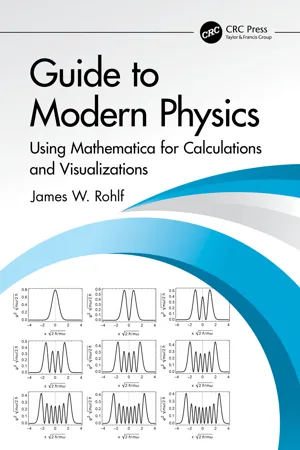
Guide to Modern Physics
Using Mathematica for Calculations and Visualizations
- 204 pages
- English
- ePUB (mobile friendly)
- Available on iOS & Android
About this book
This is a "how to guide" for making beginning calculations in modern physics. The academic level is second year college physical science and engineering students. The calculations are performed in Mathematica, and stress graphical visualization, units, and numerical answers. The techniques show the student how to learn the physics without being hung up on the math. There is a continuing movement to introduce more advanced computational methods into lower-level physics courses. Mathematica is a unique tool in that code is written as "human readable" much like one writes a traditional equation on the board.
Key Features:
- Concise summary of the physics concepts.
- Over 300 worked examples in Mathematica.
- Tutorial to allow a beginner to produce fast results.
The companion code for this book can be found here: https://physics.bu.edu/~rohlf/code.html
James Rohlf is a Professor at Boston University. As a graduate student he worked on the first experiment to trigger on hadron jets with a calorimeter, Fermilab E260. His thesis (G. C. Fox, advisor, C. Barnes, R. P. Feynman, R. Gomez) used the model of Field and Feynman to compare observed jets from hadron collisions to that from electron-positron collisions and made detailed acceptance corrections to arrive at first the measurement of quark-quark scattering cross sections. His thesis is published in Nuclear Physics B171 (1980) 1. At the Cornell Electron Storage Rings, he worked on the discovery of the Upsilon (4S) resonance and using novel event shape variables developed by Stephen Wolfram and his thesis advisor, Geoffrey Fox. He performed particle identification of kaons and charmed mesons to establish the quark decay sequence, b –> c. At CERN, he worked on the discovery of the W and Z bosons and measurement of their properties. Presently, he is working on the Compact Muon Solenoid (CMS) experiment at the CERN Large Hadron Collider (LHC) which discovered the Higgs boson and is searching for new phenomena beyond the standard model.
Frequently asked questions
- Essential is ideal for learners and professionals who enjoy exploring a wide range of subjects. Access the Essential Library with 800,000+ trusted titles and best-sellers across business, personal growth, and the humanities. Includes unlimited reading time and Standard Read Aloud voice.
- Complete: Perfect for advanced learners and researchers needing full, unrestricted access. Unlock 1.4M+ books across hundreds of subjects, including academic and specialized titles. The Complete Plan also includes advanced features like Premium Read Aloud and Research Assistant.
Please note we cannot support devices running on iOS 13 and Android 7 or earlier. Learn more about using the app.
Information
Table of contents
- Cover Page
- Half-Title Page
- Title Page
- Copyright Page
- Contents
- Preface
- Chapter 1 ◾ Basis of Modern Physics
- Chapter 2◾ Thermal Radiation
- Chapter 3 ◾ Key Processes
- Chapter 4 ◾ Special Relativity
- Chapter 5 ◾ Bohr Model
- Chapter 6 ◾ Particle in a Box
- Chapter 7 ◾ Quantum Harmonic Oscillator
- Chapter 8 ◾ Hydrogen Atom
- Chapter 9 ◾ Statistical Physics
- Chapter 10 ◾ Astrophysics
- Appendix A ▪ Mathematica Starter
- Appendix B ▪ Physical Constants
- Index